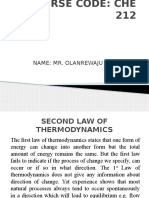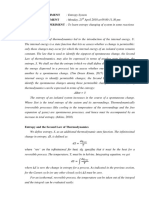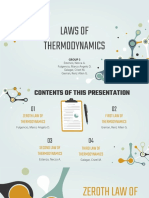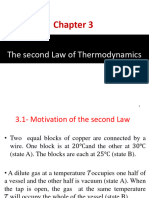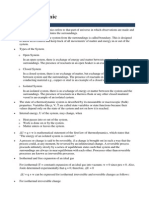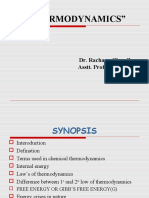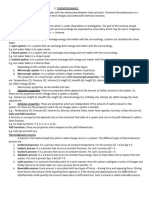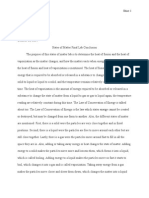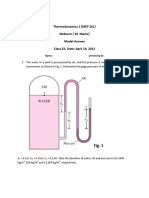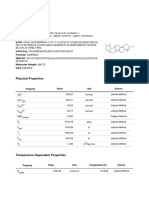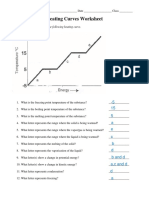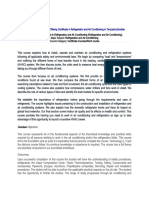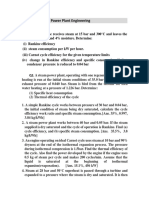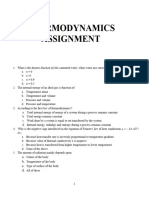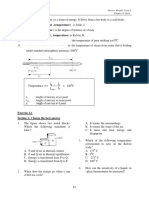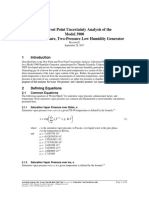THERMODYNAMICS
Thermodynamics deals with the energy changes (flow of heat) accompanying physical and
chemical processes. Thermodynamics can be used (i) to predict whether the process is feasible or
spontaneous or not and (ii) to determine to what extent the process can proceed under the given
conditions.
Thermodynamic terms
System: It is a specified portion of matter considered for the study and separated by a definite
boundary (real or imaginary)
Ex: Water in a beaker is a system
Surroundings: The portion of the universe outside the system which can exchange matter and
energy (interact) with the system is called surroundings.
System can exchange the energy with the surroundings in two ways (i) heat (ii) work
State function or state variable: The property which depends on the initial and final stage of the
system and not on the path followed is a state function. Ex: Temperature T, Volume V, Pressure
P, Enthalpy H, Entropy S and internal energy U.
Open system: A system which can exchange both matter and energy with the surroundings is
called an open system. Ex: water and water vapour in an open container.
Closed system: A system which can exchange energy but not matter with its surroundings is called
a closed system. Ex: water and water vapour in a closed container.
Isolated system: A system which can neither exchange energy nor matter with its surroundings is
called an isolated system. Ex: water and water vapour in an insulated closed vessel.
Reversible process: A reversible process is an idealized or theoretical process that occurs
infinitely slowly, allowing the system to remain in a state of equilibrium throughout the entire
process. In a reversible process, the system and its surroundings can be returned to their original
states without any net change in the system and surroundings.
Irreversible process: An irreversible process in thermodynamics is a process that is not carried
out infinitesimally slow instead it is carried out rapidly so that the system does not get a chance to
attain equilibrium.
Internal energy: Internal energy (U) is a fundamental concept in thermodynamics representing
the total energy contained within a system. It includes all forms of microscopic energy such as
kinetic and potential energy of molecules, atoms, and subatomic particles.
Enthalpy of a system: Enthalpy (H) is a thermodynamic property of a system that represents the
total heat content.
Enthalpy is defined as the sum of the internal energy (U) of the system and the product of its
pressure (P) and volume (V).
H=U+PV
�Residual entropy: Residual entropy is the entropy present in a system at absolute zero temperature
(0 Kelvin). According to the third law of thermodynamics, a perfectly ordered crystalline substance
should have zero entropy at absolute zero because there is only one possible microstate
(configuration) for the atoms or molecules. However, some substances exhibit residual entropy
due to the presence of multiple equivalent ground states or configurations, even at absolute zero.
Ex: Ice (H₂O): Ice water at low temperatures can have multiple ways of arranging hydrogen atoms
around oxygen atoms while maintaining the ice crystal structure, leading to residual entropy.
Free Energy or Gibb’s free energy: It is defined as the maximum amount of energy available in
the system to do the work. It is the difference between the total enthalpy of the system and the
product of absolute temperature and entropy.
ΔG=ΔH-TΔS
Mention the thermodynamic scale of temperature.
The thermodynamic scale of temperature is also known as the Kelvin scale. It is the absolute
temperature scale, used extensively in scientific contexts because it starts at absolute zero, the
theoretical point where all thermal motion ceases.
State I law of thermodynamics.
The first law of thermodynamics, also known as the law of energy conservation, states that
energy cannot be created or destroyed in an isolated system. The total amount of energy in a
system and its surroundings remains constant. The first law can be expressed mathematically as:
ΔU=Q−W Where ΔU is the change in the internal energy of the system, Q is the heat added to
the system, W is the work done by the system.
Write any two statements of II law of thermodynamics.
Clausius Statement: Heat cannot spontaneously flow from a colder body to a hotter body without
external work being performed on the system. (This principle underlies the operation of
refrigerators and heat pumps, which require work input to transfer heat from a cold
reservoir to a hot reservoir.) Don’t write the sentences within brackets and bold. This is for
your reference.
No heat engine can convert all the heat it absorbs into work; some heat must always be expelled
to a cooler reservoir. This statement implies that the efficiency of heat engines is always less than
100%.
What are spontaneous and non-spontaneous processes? Write the criteria for spontaneity
of a process in terms of ∆S and ∆G.
The process which proceeds by themselves and brings the system closer to equilibrium are called
spontaneous process. A non-spontaneous process is a reaction or change that does not occur on
its own without external influence. These processes require an input of energy to proceed.
�The relationship between ΔG, ΔH, and ΔS at a constant temperature (T) is given by the Gibbs
free energy equation: ΔG=ΔH−TΔS
If ΔH<0 (exothermic) and ΔS>0 (entropy increase), the process is always spontaneous because
ΔG will always be negative.
Define Joule Thomson co-efficient.
The Joule-Thomson coefficient (μJT) is a parameter that describes the temperature change of a
real gas (as opposed to an ideal gas) when it undergoes an adiabatic (no heat exchange)
expansion or compression at constant enthalpy (isenthalpic process).
The Joule-Thomson coefficient is defined as: μJT=(∂T/∂P)H where T is the temperature, P is the
pressure, H indicates that the process occurs at constant enthalpy.
Define entropy and give its mathematical expression.
Entropy is a measure of disorder or randomness of a system.
In classical thermodynamics, entropy is defined for a reversible process
ΔS=ΔQ/T where ΔQ is the heat absorbed or released during the process, T is the absolute
temperature at which the process occurs.
Calculate entropy change when one mole of ethanol is evaporated at 351K. Heat of
vaporization of ethanol 39.84kJ/mole.
ΔS=ΔHvap/T Given: ΔH of vaporization = 39.84 kJ/mol, T = 351 K.
First, convert ΔHvap=39.84 kJ/mol into J/mol
=39.84kJ/mol×1000J/kJ=39840J/mol
Now, use the formula to find ΔS
39840J/mol = 113.48J/mol/K
351K
Calculate entropy change for conversion of one mole of ice into water at 273K and 1 atm
pressure. ∆H of ice is 6.025kJmol-1. Ans: 22.07 J/mole/K
Calculate the entropy change involved in the isothermal reversible expansion of 2 moles of
an ideal gas from a volume of 2 dm3 to10dm3at 300K (R=8.314JK-1mol-1).
To calculate the entropy change (ΔS) involved in the isothermal reversible expansion of an ideal
gas,
ΔS=nRln(V2/V1) where n is the number of moles of the gas, R is the gas constant, V2 is the final
volume, V1 is the initial volume. Ans: 26.754J/K
Calculate the entropy change involved in the isothermal reversible expansion of 20 moles of
an ideal gas from a volume of 0.5 dm3 to 5dm3at25ᵒC. What is the entropy change in an
adiabatic process (R=8.314JK-1mol-1). Ans: 382.972J/K.
�Define work function or Helmoltz free energy.
Helmholtz free energy, often denoted by A or F, is a thermodynamic potential that measures the
useful work obtainable from a closed thermodynamic system at a constant temperature and
volume. It is especially useful for systems where the temperature and volume are held constant.
The Helmholtz free energy is defined as:
A=U−TS Where A (or F) is the Helmholtz free energy, U is the internal energy of the system,
T is the absolute temperature, S is the entropy of the system.
Derive Gibbs Helmoltz equation.
Consider G1 is the free energy of the system in its initial state at temperature T.
Suppose the temperature rises to (T+dT) where dT is infinitesimally (small quantity approaching
zero) small.
The free energy at the new temperature is G1+ dG1
G2 is the free energy of the system in its final state at temperature T and by G2+ dG2 at the
temperature (T+dT) at constant pressure.
If S1 and S2 are the entropies of the system in the initial and final states of the system
respectively, then
dG1= - S1dT----------(i)
dG2= - S2dT----------(ii)
Subtract equation (i) from (ii)
d(G2-G1) = - (S2-S1) dT
dΔG = - ΔS dT at constant pressure
Rearranging
dΔG = - ΔS ----------------(iii)
dT p
We know that ΔG=ΔH-TΔS
-ΔS = ΔG – ΔH ---------(iv)
T
Equating (iii) and (iv)
dΔG = ΔG – ΔH
dT p T
ΔG = ΔH + T dΔG
dT p
This equation is known as Gibb’s Helmoltz equation. It is applicable to all process occurring at
constant pressure.
Discuss spontaneity of a process with respect to free energy change.
ΔG<0: A process is spontaneous if the Gibbs free energy decreases. This indicates that the
process can proceed without requiring an external input of energy; it releases energy to its
surroundings.
ΔG>0: A process is non-spontaneous if the Gibbs free energy increases. This indicates that the
process requires an input of energy to occur; it absorbs energy from its surroundings.
�ΔG=0: A process is at equilibrium if the Gibbs free energy does not change. The system is in a
stable state, with no tendency to undergo further change without external influence.
Spontaneous processes tend to move towards a state of lower Gibbs free energy, leading to
increased entropy (ΔS>0)
State III law of thermodynamics.
As the temperature of a system approaches absolute zero, the entropy of a perfect crystalline
substance approaches zero.
State zeroth law.
If two systems are each in thermal equilibrium with a third system, then they are in thermal
equilibrium with each other."





